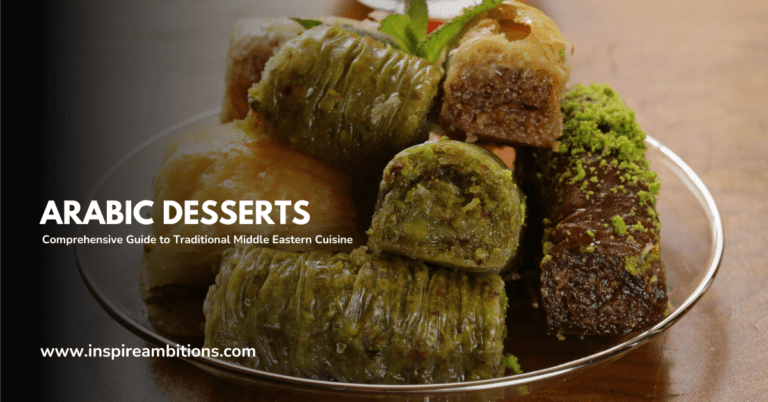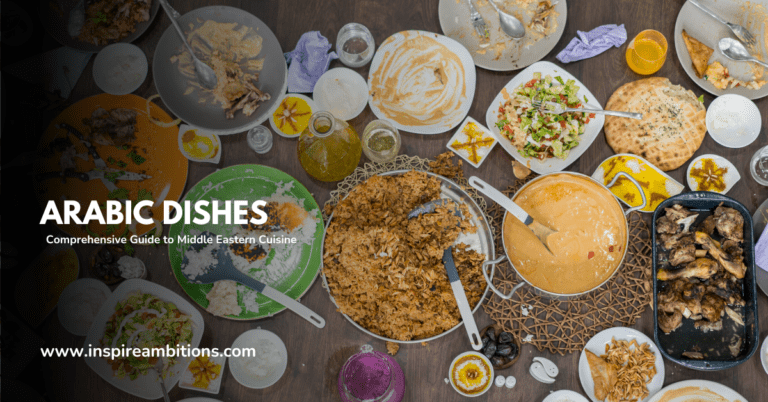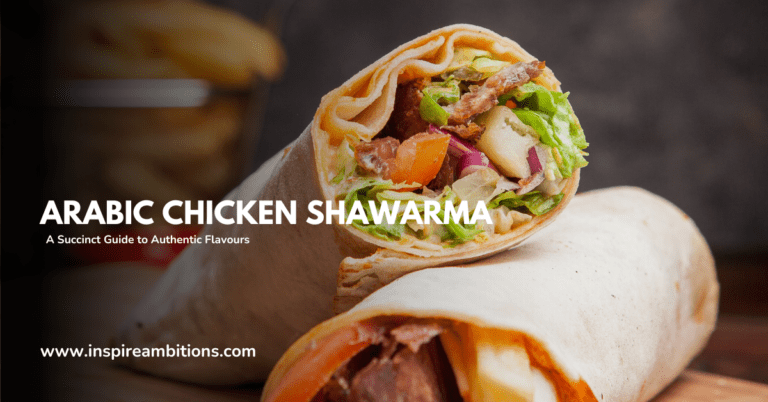Lebanese Pita Bread – The Ultimate Guide for Authentic Flavours
Lebanese pita bread, also known as Arab or Syrian bread, is a staple in the Middle East and an essential component in many traditional dishes. This soft, pillowy bread is not only enjoyed by itself but is often used as a versatile accompaniment to various meals.
From serving as a base for delightful wraps to acting as a utensil in scooping up mezze or dipping into aromatic sauces, pita bread’s importance in Lebanese cuisine cannot be overstated.
To prepare Lebanese pita bread, you need only a few simple ingredients – typically, flour, water, sugar, and yeast. The trick to achieving the perfect pocket in your pita lies in the baking process. Preheating a pizza stone or an inverted baking tray at a high temperature of around 500°F (260°C) is crucial.
Placing raw pita dough on a hot surface will cause the water to evaporate, and steam will inflate the dough, creating that signature pita pocket.
Delving deeper into the world of Lebanese cuisine, we will explore the history, cultural significance, and various uses of pita bread.
This journey will not only broaden your understanding of this culinary staple but also inspire you to try your hand at making fresh, homemade pita bread to enhance your culinary experience.
Origins of Lebanese Pita Bread
Lebanese pita bread, also known as khubz, has a rich and fascinating history. It is believed to have originated around 4,000 years ago in the Middle East, with possible roots in the ancient Amorite culture of Mesopotamia, which is now modern-day Syria and Palestine.
The word “pita” simply means “flatbread,” and this type of bread has been a staple in the region for millennia.
In ancient times, the fertile land of the Fertile Crescent attracted travellers and conquerors from various regions.
As they spent time in this area, they undoubtedly contributed to the development and spread of pita-like flatbreads, which were made using basic ingredients such as wheat flour, water, and salt. These early types of pita bread were cooked in a tinûru, or tandoor oven, much like today’s tandoor bread.
Lebanese pita bread, often referred to as “pocket” pita bread due to its hollow interior, has featured prominently in the region’s cuisine. It’s used in a variety of dishes, from humble sandwiches and wraps to more elaborate dishes featuring grilled meats and vegetables.
The bread’s unique texture and taste have made it popular not only in the Middle East but also around the world.
Although pita bread is not exclusively Lebanese in origin, it is an essential part of the country’s culinary heritage. As it has evolved through the centuries, it has become a beloved and versatile staple in Lebanese kitchens.
Today, pita bread can be found in many forms and flavours, reflecting the diverse culinary landscape of Lebanon and the wider Middle East.
Remember that while pita bread may have a long and storied history, it remains as delicious and vital to the cuisine as ever. Its versatility and ability to complement a wide variety of dishes continue to endear it to both cooks and diners alike.
Ingredients of Lebanese Pita Bread
Lebanese pita bread is a delicious and versatile flatbread that is a staple in Middle Eastern cuisine.
This recipe is simple and requires only a few basic ingredients to create a soft, pillowy bread perfect for serving with dips, sandwiches, or as a snack on its own. In this section, we will explore the key ingredients needed to make this tasty bread.
Flour
The main ingredient in Lebanese pita bread is wheat flour. This type of flour provides the necessary protein and gluten content for the pita bread to rise and hold its shape.
Typically, all-purpose or bread flour is used; however, whole wheat flour can also be used as a more nutritious and fibre-rich option.
Water
A key ingredient in the dough mixture is water. It is essential to use lukewarm water (not too hot, not too cold) to activate the yeast, which helps the dough rise. The water also helps to create a moist dough, contributing to the soft, fluffy texture of the pita bread.
Yeast
Yeast is a vital ingredient in the making of Lebanese pita bread, as it is responsible for causing the dough to rise and allowing the formation of the signature pita pocket. Active dry yeast is commonly used, and it is essential to ensure that it is still active before starting the process.
To check if the yeast is still active, combine it with lukewarm water and sugar, and let it sit for several minutes. If bubbles or froth form on the surface, the yeast is still active.
Sugar
A small amount of sugar is added to the pita dough for a subtle hint of sweetness. More importantly, sugar serves as food for the yeast, helping it to activate and produce the necessary gases to raise the dough. Regular granulated sugar is suitable, and only a small amount is needed for the desired effect.
Salt
Salt is an essential ingredient in most bread recipes, including Lebanese pita bread, as it adds flavour and helps to strengthen the gluten bonds in the dough.
It also plays a role in controlling the yeast activity, ensuring that the dough does not rise too quickly. Using the right amount of salt is key to achieving the perfect balance of taste and texture in your pita bread.
The Baking Process
Here’s how to bake it:
Preparation of Dough
To begin with, prepare the dough by combining flour, water, yeast, and salt. Mix these ingredients until a soft and slightly sticky dough forms. Knead the dough for about 10 minutes until it becomes elastic and smooth.
Once the dough is ready, cover it with a damp cloth and let it rest in a warm place for about an hour or until it doubles in size.
Shaping and Second Rise
After the dough has risen, divide it into equal portions. Roll each portion into a ball and flatten it slightly. Using a rolling pin, roll out each dough ball into a thin circle, approximately 6 inches in diameter and ¼ inch thick.
Don’t worry if they’re not perfect circles, as they will still taste delicious. Place the rolled-out dough circles on a floured surface and let them rest for another 10-15 minutes. This second rise is essential, as it helps form the pocket characteristic of pita bread.
Baking at High Heat
Before baking, preheat your oven to 500°F (260°C). Place a pizza stone, baking stone, or an inverted baking tray inside the oven to heat up as well. Once the oven and baking surface are blazing hot, place the raw, uncooked pita onto the stone surface.
The intense heat will cause the water in the dough to evaporate quickly and create steam, which results in “inflating” the pita bread and forming a pocket. Bake the pita for about 2-4 minutes, or until they puff up and have a light golden colour.
Remove the freshly baked pita bread from the oven and wrap them in a clean cloth to keep them warm and soft.
Cultural Significance in Lebanon
In Lebanon, pita bread holds a significant place in the everyday lives of the people. As a staple food, you’ll find pita accompanies many meals, often serving as a tool for scooping up tasty dips or sauces. Its versatility and satisfying taste have made it an essential part of Lebanese cuisine for centuries.
While pita bread is enjoyed across the Mediterranean, Levant, and neighbouring areas, the Lebanese version has its unique characteristics. It’s typically thinner and larger than other varieties, allowing for greater flexibility in its use.
When eating traditional Lebanese dishes like hummus, tabbouleh, kibbeh or shawarma, pita bread is always at the heart of the table.
In the diverse culinary landscape of Lebanon, pita bread is an equaliser.
Regardless of the dish, you’ll find that it unites the flavours of diverse ingredients, enabling the creation of harmonious meals. Pita bread transcends beyond just the culinary realm; it also represents Lebanese hospitality and the warmth of their shared dining experiences.
As a reminder of the importance of breaking bread together, pita bread is often present at both family gatherings and friendly get-togethers.
Sharing pita fosters a sense of community and connection, making meals not only about nourishment but also about unity and communication.
Next time you find yourself enjoying a delicious Lebanese meal with pita bread, remember its cultural significance. This humble, yet essential, ingredient is a testament to the importance of food in bringing people together and celebrating the rich traditions of Lebanese cuisine.
Nutritional Aspects
Lebanese pita bread offers various nutritional benefits to your diet. These breads contain essential macronutrients such as carbohydrates, protein, and fats. Specifically, a typical serving of Lebanese pita bread provides 44g total carbs, 44g net carbs, 1.2g fat, 11g protein, and a total of 242 calories.
As carbohydrates serve as your body’s primary energy source, consuming moderate amounts of pita bread can be beneficial. However, remember to consider your daily caloric needs, especially if you have specific dietary requirements or goals.
In addition to its macronutrient profile, Lebanese pita bread contains dietary fibre, at approximately 1g per serving. Including fibre in your diet aids digestion and helps in reducing the risk of heart disease and type 2 diabetes.
Whole grain pita bread, in particular, packs a relatively higher fibre content, making it a healthier choice.
Lebanese pita bread’s nutritional aspects are fairly low in fat, particularly saturated fats, which contribute to better cardiovascular health. However, bear in mind that individual pita breads can have varied nutritional content depending on the brand or ingredients used.
Incorporating Lebanese pita bread into your meals is a simple and delicious way to enhance your diet with essential nutrients. Just remember to consume them in moderation alongside a balanced and diverse range of foods to uphold a healthy and well-rounded diet.
Common Uses in Lebanese Cuisine
In Lebanese cuisine, pita bread is a staple that accompanies many dishes, adding versatility and flavour to your meals. Here are some common ways to incorporate Lebanese pita bread into your culinary adventures.
Pita chips:
A healthier alternative to potato chips, pita chips are easy to make. Simply cut your pita bread into small triangles, lightly spray them with oil, and spread them on an oven tray lined with baking paper. Bake until crisp and enjoy with your favourite dips like hummus, baba ganoush or tzatziki.
Fattoush salad:
This refreshing Levantine salad features pieces of crispy or toasted pita bread, mixed with fresh vegetables like tomatoes, cucumber, radish and herbs such as mint and parsley. The pita adds a delightful crunch to the dish while soaking up the tangy lemon and olive oil dressing.
Lamb fatteh:
A classic dish with layers of spiced lamb mince, chickpeas and yoghurt sauce, lamb fatteh uses crispy Lebanese bread to add texture and flavour. Serve it to a group for a delicious and satisfying meal.
Pita sandwiches:
Pita bread is perfect for creating mouth-watering sandwiches. Stuff it with seasoned grilled meats like shawarma or souvlaki, falafel, or simply with your favourite vegetables, cheese and spread for a tasty and portable meal.
Tabbouleh:
This popular side dish features finely chopped parsley, bulgur wheat, tomatoes, onion, and a zesty lemon dressing. Enjoy tabbouleh scooped up with pita bread for a flavourful and nutritious bite.
Pizza:
Transform your pita bread into a quick and easy pizza base by spreading a thin layer of tomato sauce and topping it with your favourite pizza ingredients. Bake it in the oven for a few minutes until the cheese is melted and bubbly. Your personal pita pizza is ready to devour!
Incorporating Lebanese pita bread into your dishes, you’ll discover the wonders of this versatile, delicious and timeless ingredient. So next time you’re planning your menu, consider the many possibilities that pita bread can offer.
Varieties of Lebanese Pita Bread
There are several varieties of Lebanese pita bread that you might come across, each with its unique characteristics. While all types of Lebanese pita bread are similar, being round and flat, they can slightly differ in terms of ingredients, taste, and texture.
The most common type of Lebanese pita bread is khobz. This is a versatile bread that can be used in numerous traditional dishes, such as falafel wraps or shawarma.
Khobz is typically made from a mixture of white flour, water, yeast, and salt. It is leavened to create a soft, fluffy texture that easily absorbs sauces and pairs well with flavourful dips like hummus.
Shami bread is another variety found in Lebanon and surrounding regions. Shami bread is similar to khobz, but it often includes whole wheat flour, giving it a slightly denser and more rustic texture.
It’s popular for toasting and used as a base for dishes like Manakish, a pita bread topped with spices and herbs like zaatar.
In addition to these primary varieties, you may also come across mafrood, burr, bairuti, and other regional types of Lebanese pita bread.
While these pita bread variations may differ slightly in terms of ingredients or methods of preparation, they all serve as a delicious accompaniment to dips, grilled meats, and other dishes in Lebanese cuisine.
Each of these pita bread types can be enjoyed in different ways, depending on your preferences and the dish you’re preparing. Whether you’re dipping it into rich, creamy hummus or wrapping it around tender marinated meats, Lebanese pita bread remains an essential ingredient in Mediterranean cooking.
Purchasing and Storing Tips
When purchasing Lebanese pita bread, look for a fresh and soft texture. The bread should be slightly moist and pliable, but not overly damp or soggy. Keep an eye out for a slightly golden colour, and avoid bread with dry edges or an overly pale appearance.
To store your pita bread at home, there are a few options you can consider, depending on the length of time you plan to keep it:
- Short-term storage (up to a few days): Wrap the pitas in a slightly damp paper towel and place them in a sealed plastic bag. This will prevent the bread from drying out while maintaining its soft texture. Store the bag in a cool, dark place like a bread bin or pantry.
- Medium-term storage (up to a week): If you need to store pita bread for a longer period, consider placing the wrapped pitas in the refrigerator. First, wrap the pitas in aluminium foil to preserve their freshness. Then, store the wrapped pitas in the main compartment of the refrigerator, away from strong odours.
- Long-term storage (up to a few months): Freezing pita bread is the best option for long-term storage. Simply place the pita bread in an airtight freezer-safe container or zip-lock bag, making sure to press out any excess air. Store the bread in the freezer for up to three months. When ready to use, allow the frozen pita to thaw at room temperature or in the refrigerator.
If you have made pita dough but are not yet ready to bake, you can store the dough in the refrigerator for up to a week. Prepare your dough until the first rise, then punch it down. Wrap the dough securely in plastic wrap and place it in the refrigerator.
Remember to keep your pita bread away from moisture and heat sources, as these can cause the bread to spoil or develop mould. By using these purchasing and storing tips, you can enjoy Lebanese pita bread at its best.






